

THE SHENANDOAH WASHBOWL AND PITCHER OF THE VICTORIAN PERIOD.
There were at least five different potters within the Shenandoah Valley who produced the Washbowl and pitcher in matching sets: Anthony W. Bacher, the Strasburg Bells, the Eberlys, James Mackley of Thurmont, Maryland, and Emanuel Suter of Rockingham County.(1) Suter produced his style in what could be considered a classical design. The other four producers, all located in the lower Valley, produced their sets in what can be describe as a German or Bacher design.
ANTHONY BACHER:
Anthony Bacher was the originator of this Lower Valley style. His German, Bavarian, training, he the son of a German potter father, brought Germanic ceramic designs to the Valley. Bacher, a Frederick County Virginia potter between 1854 and 1889 produced ware that is today the pride of many American museums and collectors. He also managed and was employed by the Lynn Pottery and the Simons Pottery, which was the last two years of this former Lynn Pottery operation, in Thurmont, Frederick County, Maryland. He traveled from Frederick County, Virginia, to Frederick County, Maryland, by train during various times of the Lynn and Simons period; about 1845-1883.
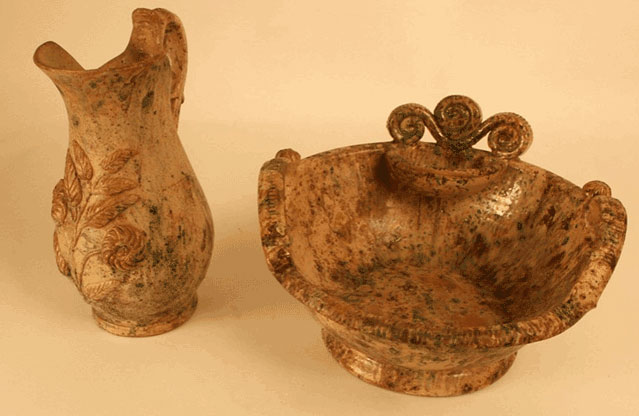
Pitcher 11 1/4 in. h., Bowl 12 3/4 in. h. Private Collection.
Bacher's production of the washbowl and pitcher presented a new form to the Shenandoah Valley.( See below the work of Lorenzo Fleet.) The thrown Washbowl and pitcher shown here has been finished with engobe, ( a white liquid clay in slip form to mask the reddish color of the earthenware) sprinkled or flecked with copper oxide, (green) and manganese dioxide, (brown) and covered with lead oxide. This presents an interesting and attractive glaze. Other Bacher items have surfaced with similar glaze but are rare. This glaze form is of ancient German derivation. John Bell of Waynesboro, Pennsylvania occasionally used a similar, but brighter, such glaze. This set exhibits the classical Lower Valley form: Early German style pitcher with decorated handle and front surface. The front surface has decorative sprigging.( adding molded figures to the surface of a vessel) The washbowl has a soap dish and three rosettes above, which are connected to the rim. The handles are pulled and hand decorated with gadrooning . Behind each handle there is a incised ball supplying decoration and support for the handle. The front part of the bowl is cut to a lower level than the back area. This function prevented over filling to the extent that water could not come in contact with the bottom of the soap dish which was pierced. All other Lower Valley makers produced their washbowls with similar architecture as did Bacher. Decorated Valley washbowl and pitcher sets vary in their decorative sprigging but are variants of the Bacher technique.
JAMES MACKLEY:
Bacher's protégé, James Mackley, worked with him in Thurmont Maryland, where the later conspicuously mimicked his mentor and perhaps produced ware in a more opulent manner than the tutor. Mackley learned his trade in Maryland prior to an association with Bacher. As an employee of Bacher's at the Thurmont, Lynn pottery, he became captivated by Bacher and his work and has produced some of the best period Bacher style products yet to be found, including those by Bacher. That is to say, his products exhibit a softer, gentler art application than does Bacher's more hurried appearing products. One of the Valley's most desirable washbowl and pitcher sets is in the collection of the Frederick County Maryland Historical Society and is shown below.
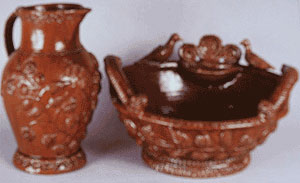
Pitcher, 11 ˝ in. h., bowl, 13 ˝ in. w.
The Mackley washbowl and pitcher were produced by throwing. His decorative scheme is strictly Bacher in nature. These items are glazed with engobe, a light manganese wash and lead oxide. Note how the light manganese wash pooled in the stamped flower spaces on the pitcher base causing a dark brown color. The handles are pulled and hand decorated. The addition of birds perched on the bowl rim is indicative of both Bacher and Mackley. These bird additions are unfinished on the back surface of this example. Bird additions have not been observed on any other washbowls made within the Shenandoah Valley other than the products of these two potters.
Strasburg, Virginia
During the War Between the States, Strasburg's pottery industry all but shut down. Lorenzo Fleet who came to Strasburg in 1844 had become one of the most productive potters there, always working for others. He did not become a solider for the South and needing to support his family he gained employment in Frederick County, at the Bacher shop. Bacher, with no particular political ambition, was able to stay in business during the conflict, in spite of the fact that his pottery was heavily damaged by the Yankees. Fleet worked with Bacher almost four years. Fleet had a potter son, Theodore, who was an outstanding potter in Strasburg, Frederick County's Round Hill pottery, and Chucky Valley Tennessee. Lorenzo's exposure to Bacher's methods and styles gave Fleet the necessary information to share with the Strasburg pottery industry when he returned after the War. The Strasburg Bells and the Eberlys were the primary earthenware producers after the War period. Both potteries employed Fleet at various times and were the only Strasburg producers of washbowl and pitcher sets. No stoneware examples have been found.
Although certainty can not be discerned, it is most probable that the Bells were the first producers of the Bacher style washbowl and pitcher. Such products from the Bell shop are exceedingly rare. The Eberlys are not believed to have produced the washbowl and pitcher until after 1885. No washbowl and pitcher sets have surfaced with the Bell maker's mark. Two Eberly sets are known to be so marked. Both makers used similar glazes for their surface finish. While the Eberlys used the throwing technique for both washbowl and its accompanying pitcher, the Bells molded the pitcher and also the bowl handles.
The BELLS and EBERLYS:
It is probable that the Bell washbowl and pitcher was produced during the Solomon Bell era.(1841-1882) however, at least prior to the time that the Eberly production began. The pitcher was molded and the bowl, the largest of the Valley production, was thrown. The pitcher shown is seated squarely on its bottom. Its form varies with other Valley pitchers and the handle was molded along with the pitcher, at the same time, in the same mold. The handle has an applied clay knob at its apex.
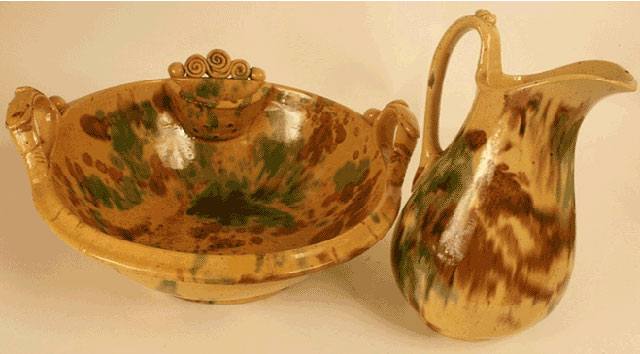
Pitcher, 12 ˝ in. h. Bowl 15 ˝ in. w. Private Collection.
Beneath the upper handle on the surface of the pitcher body there is located a molded tied-bow in a horizontal direction. Basic decorations are soap bowl, three back rosettes with flanking clay balls of which similar ones are also posted back of molded handles. Such Bell products are not known to have any sprigged decorations. In these products the glazed finish of engobe, manganese, copper oxide, and lead oxide sufficed as decoration. It is likely that Lorenzo Fleet produced these at the Bell shop. Pitcher, 12 ˝ in. h. Bowl 15 ˝ in. w. Private Collection.
The Eberly washbowl and pitcher follows the Bacher style more closely than the Bell products. Both members of the set were thrown. No Bacher sprigged style decorative sets are known by these potters. However, there are known pitchers with a Bacher sprigged style decoration that may have been teamed with bowls, either sprigged or decoratively glazed.
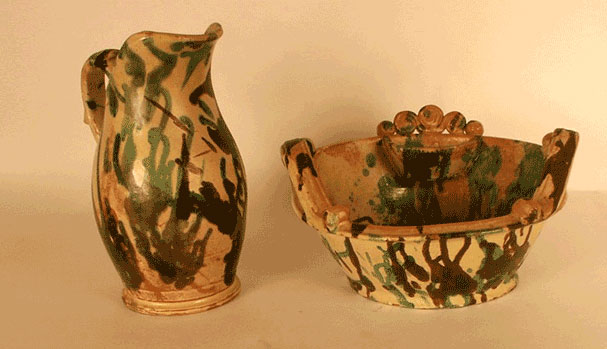
Pitcher 11 ˝ in. h., Bowl 12 ˝ in. w. Private Collection
The Eberlys often simulated a screw head holding down the front of the bowl pulled handles and the lower terminal of the pitcher handle.The Eberlys also made washbowls in a plain, no frills, design. The example shown here is one of the two known with the maker's stamp. The stamp, Eberly and Co./ Strasburg, Va., is the stamp styled by the shop when Letcher Eberly became manager.
EMANUEL SUTER:
Emanuel Suter's washbowl and pitcher products were produced through the molding and jollying-jiggering techniques. None of his sets have ever surfaced dated, and it is most probable that none were produced until he began production at his ca. 1866, "New Erection" pottery site. Perhaps such sets were even a later product when he powered his pottery with steam power. His short-lived ownership of the steam pottery may account for the rarity of his washbowl and pitcher sets.
Unlike other Valley products of the same type, Suter's washbowl and pitcher products were within a common, period style. This is by no means a comment on his abilities; he was among the very best within the period. His primary customers were the local Mennonites who were his most loyal buyers. While a large group, these local inhabitants were wont to live a more meager life style and had no need for opulent pottery products.
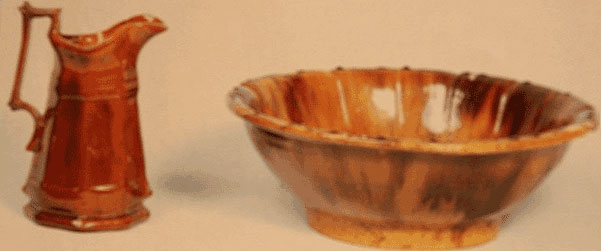
Pitcher, 9 in. h., Bowl, 14 in. w.
The above washbowl and pitcher is attributed to Emanuel Suter. The pitcher is a molded copy of an English ironstone form. The prototype of the bowl is unknown to this writer. The bowl style however, was not a simple design. As many potters were guilty of doing, making copies of pre-existing forms was not a punishable action during the 19th century.
Both items were of earthenware and glazed with engobe, manganese and lead oxide. The bowl form is most likely a product of jiggering.
This Suter washbowl and pitcher is in the collection of the Eastern Mennonite University Archives, Harrisonburg Virginia.
Reference:
1. For a more complete history of the potters mentioned, see these publications: “The Pottery of the Shenandoah Valley Region,” Comstock, H. E., The Frank L. Horton Series, The Museum of Early Southern Decorative Arts, Winston-Salem, North Carolina, 1994.
2. Shenandoah Pottery, Rice, A. H. and Stoudt, John Baer, Shenandoah Publishing House, Inc. Strasburg, Virginia, 1929








